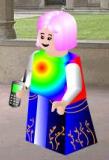 Introduction
IntroductionKim Woods introduces us to the proliferation of literature on art, painting, architecture etc. that came about during the years of the Renaissance. She highlights the most famous, Vasari's Lives, but points out that in both North and South Europe there were many other writings and treatises. There seems to be a question as to how much influence these actually had on workshop training
Views from German speakers 1505-1532
All the writings considered are from German scholars written in Latin. By far and away the most important artist written of is Durer, who is compared time and again to the ancient artists and compared to Giotto in bringing back the ancient skills. The earliest lengthy personal tribute to have been printed in the Western European tradition was that by Camerarius of Albrecht Durer, who sees Durer not only as an artist, but as a theorist who established universal rules for proportion etc. In this way he saw him as more than passing on his learning, but rather as disseminating his ideas very widely. Mention is also made in this section of Lucas Cranach the Elder (1472-1553)
Italian views 1510-1530
This section reports on a number of developments. The guide books of Francesco Albertini of Florence and Rome, which as well as, telling of the ancient wonders also included contemporary and more recent works of art. In this period Giovio sought to establish a museum displaying portraits and information on artists and his early writings led him to encourage Vasari to produce the Lives. Two means of reviewing contemporary and modern artists emerged, one in which the writer sought to identify artists as the best and then working down, but others that recognized many artists as having different abilities. Giovio also wrote exclusively of Leonardo praising his ideas and his inventiveness over his work both finished and unfinished.
3. Treatises (writings on theory and practices)
An overview which tells us that treatises were produced both 'top down' from the intellectual elite and 'bottom up' from aspiring artists. Their value to patrons and collectors and to artists depended upon their language as this could give them either a wide audience or a very select one.
Treatises in one language
This section reviews a number of treatises two of which were not printed and widely distributed. Ghiberti's manuscript called Commentaries part three of which deals with the sciences of perspective, anatomy and proportion, and Leonardo's drafts for his treatises.
More widely available were works by Cennino and importantly Alberti who as well as being a painter, sculptor and architect, was a scholar. His important work included commentary on and a modernisation of Vitruvius' De Architectura.
Latin and vernacular treatises - manuscripts
A review of a number of manuscripts by writers such as Baptista Alberti, Filarete, Piero della Francesco and how copies were made and dedicated to specific men or rulers, sometimes in the hope that ideas would be supported by them. This section deals almost exclusively with Italian artists.
Latin and vernacular treatises - printed treatises
Against the almost exclusive audience of manuscripts, the printed treatises of the likes of Albrecht Durer had a wide circulation and became text books for teaching perspective and proportion. These were also translated and reproduced in different languages. Durer also acknowledged the aesthetic of diversity stating that beauty came in different ways for different people.
Conclusion
In conclusion, Catherine King poses the questions as to who valued treatises and what influence did they have upon patrons, scholars and artists. She suggests that they had some influence and did effect some changes, but that it is difficult to fully evalute these.




